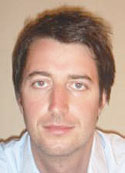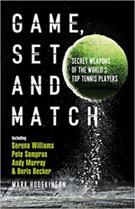The Bryan Brothers:
Principles of Winning Doubles
Mark Hodgkinson
In this excerpt for his book, Game, Set and Match, noted tennis journalist Mark Hodgkinson outlines the Bryan Brothers principles of doubles that have made them the most successful team in tennis history, based on his exclusive interviews with Bob and Mike.
Holding Serve
You need a higher first-serve percentage in doubles than you do in singles: "In singles you can serve 50 per cent and be fine, but in doubles you need to serve high 70s."
"So a lot of the time we won't go for the flat bomb. We will take off 10mph. We'll go for the higher-percentage serve."
The body serve is great in doubles: "It cuts down opponents’ angles and jams them and reduces their options, and that frees up your partner at the net to poach. Also, when you go for a body serve, you're not going to miss the serve wide so that helps to keep your percentage up."
Have a plan for every point: "We make a quick signal before the point. It really helps the guy at the net to know where his partner is going to serve, as then you have a bead on the return."
"For example, if your partner is going to serve wide, you need to be covering the line. A lot of the time it's just one word here or there; we don't need a long conversation. We keep it short, with code words."
"The server is usually the one who decides where the ball is going to go. He's the one who is calling the pitches--unless the poacher really sees a tendency or feels strongly about a particular serve. The rest of the time, it's the server who calls the shots."
If you're playing a really hot returner, think about changing your formation: "We try to create indecision in the other team's heads."
You don't want any surprises, so do your homework: "When we walk on court, we want to already know where they like to return. Do what you can to take away their best shots."
Breaking Serve
You have to hit an aggressive return: "In doubles, it's not just about making the return. You have to go for it."
"When one of us hits a great return, and it's a laser-beam, and it just misses, the other one will say, That was positive, that was a great way to hit it. We like to praise those misses because we know that, over time, you will get rewarded for taking that sort of risk."
If you hit a singles return on a doubles court, it's going to get smashed: "You have to hit returns near the alley and low. Otherwise it's a throwaway return: Singles and doubles are completely different games."
"The best singles players can't just walk on to a doubles court and play good matches. It's something you have to work on."
The player at the net has to be really active and aggressive with the poaching in return games: "You want to make strong diagonal moves to cut off shots, and make it hard for your opponents with the first volley, and try to create some doubt and indecision in their minds."
"If you can make a good return, and then a good poach, you will be in great shape to break serve." Do your research on your opponents' serving tendencies and where they serve on the big points: "That will help you to be really aggressive."
Poaching
The key to a good poach is being close to the net. It's about exploiting the middle of the court:
"In doubles, poaching will always be relevant. Even when you watch all the guys who rip from the baseline, their net play is still pretty accurate, moving towards the middle. The key is getting across the middle and exploiting the middle of the court."
Keep your hands way out in front of the body. A good split step is huge. You need a quick burst of energy:
"A lot of times it's about moving toward the net strap and getting as close to the net as possible, that's what makes for a put-away volley and an easy intercept. It's about closing the net down."
Throw in a head fake, play a game with your opponents. Wait for as long as possible before making your move - until your opponent is committed to their shot: "You don't want to move too early, and you don't want to move too late."
You need your partner to be making a lot of low returns: "If he can keep the ball low, your opponents will have to hit up, and you're going to have more opportunities."
You want to make that move right, as they've committed to their shot. But when you do move, you have to move quickly.
Visualize where you think the ball's going to be, and then react to that, go and get that space on the court: "It's too late if you're still thinking."
When you move, move forward in a diagonal direction: "You don't want to move too far laterally and remember to make it quick."
Basic Errors
One basic error is lack of communication. If you're going to serve wide, make sure you tell your net man: "If you don't tell him, and he's close to the middle of the court, you're going to get burned down the line the whole time. That's a common mistake."
Another error is being passive: "You mustn't be slow and fearful. You shouldn't be on your heels. You need to be on your toes. Your weight should always be going forwards, and you should be hitting the ball in front of you."
How to Treat Your Partner
Always be positive when speaking to your partner on the court: "Sometimes you're going to have to fake it. You're only half of the team and you need your partner feeling great and playing the best that he can."
Never order your partner around. Never roll your eyes when talking to your partner. If you've just had a bad defeat, clear the air right away. And be honest: "We like to hash it out pretty quickly after a match. We will tell it straight."
"Two professionals who aren't brothers would probably never say the stuff that we say. We get it out there, even if it's not friendly. We'll say some really personal stuff that we know will cut the other twin to the core."
"But that means that we can let off a lot of steam, and clear the air. Other players might have some lingering problems and drama that will get them in trouble for a whole month or two months and could end the partnership."
"Obviously it helps that we're twins and we have a bond which is never going to break. We're not looking around for another partner, and the other one knows that."
Violence should never be condoned --but sometimes it can work: "We've gotten physical. We've thrown punches and thrown stuff. We've broken guitars against the wall, thrown shoes, and hurled a glass bottle across the room, shattering it."
"Our biggest fight was after a first-round match at Wimbledon one year. We had had a barn-burner on the court. We actually won, but it was a terrible match. We threw some punches in the back of the car that was taking us from Wimbledon, and then when we got to the apartment, we ran up the stairs and broke some stuff, including a guitar."
"We were so pissed off with each other. And then we ended up winning the tournament. There have been other times that we've been on a flight, jabbing at each other, and a stewardess has come up to us and said, "Is everything OK here?" We will wait until she leaves and then go back at it."
Training for Doubles
You shouldn't train for doubles in the same way you train for singles: "We work as hard as singles players, it's just that we're doing different stuff. We're in the gym as much as we're on the court."
"As a singles player, you need to do a lot of cardio to be ready to play. You don't need that as much in doubles. In doubles, the points are much shorter. You need a strong core and strong legs. But our legs are pretty skinny compared to the singles players."
Doubles is a fast twitch game. So you need to be able to make quick, explosive movements:
"Obviously playing singles is more gruesome on the body with the endurance, but in doubles you're always crouched down and you have to make very explosive moves.
When the singles guys come and play doubles, they tend to be a little flat footed. It takes their eye a little while to get adjusted. You have to see everything way out in front. You have to be fast."
You should be doing lots of preventative work, and with every part of your body: "For a tennis player, your body is your business, so if we have a week off between tournaments, we're in the gym a couple of hours a day."
Do a lot of resistance band sprints and movement: "Put the harness on, and move about the court--back-pedaling, changing direction, that sort of stuff."
"We also do that in sand, which strengthens your ankles. So, when you get back on the court, it feels a little easier. We're always in that crouch position, and you want to get out of that position as quickly as possible so we do a lot of static stuff and biometric jumps."





